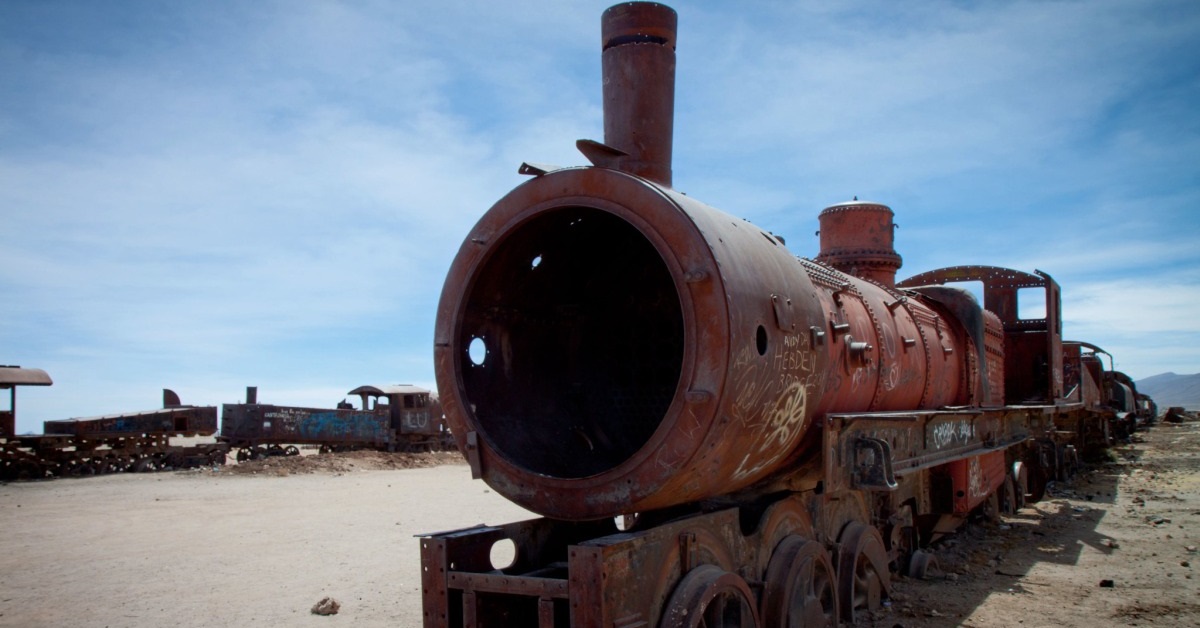The largest salt flat in the world also holds one of the largest collection of abandoned trains from a different era.

Uyuni is a small town in the southwestern part of Bolivia, only 217 miles (350 kilometers) away from the capital La Paz. Located on the mountainous plains of the Bolivian Andes, the town sits at an elevation of 12.139 feet (3700 meters). It’s mostly known for being the gateway to Salar de Uyuni, the world’s largest salt flat, or the ‘Largest Mirror on Earth’, that covers an area of 3900 square miles (10.000 square kilometers). It formed when a number of prehistoric lakes dried, and left a desert of salt in their wake.
Even though the giant salt flat is pretty much inhospitable to most animals, every November, it serves as a prime breeding ground for flamingos, who very much favor saline-rich environments. It’s also a popular tourist destination, and has even been used as a filming location for Hollywood movies, like Star Wars.
Another interesting attraction in the area is ‘Cemeterio de Trenes’ – a giant time capsule. Just 1,9 miles (3 kilometers) from the town of Uyuni, dozens of old locomotives left to rust on long-forgotten train tracks remind us of Bolivia’s mining past.

Uyuni was founded at the end of the 19th century as a trading post. Later, it became a very important transport hub, since it was the meeting point of 4 different railway lines that connected major cities, and its position also provided a crossing point to Chile, and Argentina.
The railroad was built by the Antofagasta and Bolivia Railway Company between 1888 and 1892. They called in British experts for the project, and even imported locomotives from the United Kingdom. The plan was to carry more minerals from the Bolivian mines, all the way to the coasts of Chile. The Bolivian authorities were in favor of these new lines as well. They were hoping that the country would flourish thanks to the modern transport system, and good connections to the Pacific ports.
These plans actually came to fruition, and the mineral mining industry was booming in Bolivia – for a while at least.

One of the most profitable minerals at the time was tin, and Bolivia was one of the largest producers in the world. And as the mineral industry was growing in the country, so was the importance of Uyuni that connected the key locations in the area. With a large chunk of the world being at war with each other during the first few decades of the 1900s, demand for minerals and other resources grew even larger.
However, this sudden boom in the mining business eventually caused its downfall. After World War II, the Bolivian mineral mining industry began to decline, and eventually collapsed. Many of the mines had to be closed due to being exhausted from the intense mining. Since the volume of mineral mining drastically dropped after the collapse, there wasn’t much need for many of the trains and railroads that had been used to transport these materials. So, they were simply abandoned, which ultimately led to the creation of a graveyard of trains. It would have been much more expensive to transport them back, and leaving them far from everything seemed like an easy, and obvious solution.

More than 100 trains from the mining era have met this fate. The once state-of-the art locomotives, which played a key role in Bolivia’s mining industry, have been stripped of useful parts, and only their hollowed out bodies remain in the cemetery. The natural elements also took a toll on the abandoned trains. The salty winds that blow over the area have corroded the steel trains that have been standing in one place for decades.
There are no fences, guards, or any restrictions around the graveyard, so people can pretty much go there whenever they want. In fact, it became a somewhat popular tourist attraction in the area, and every guided tour visits the old locomotives. Due to the lack of restrictions and maintenance, however, the rusted out trains are heavily vandalized, and covered in graffiti. This is something visitors should keep in mind, though, because climbing the wrecks could be dangerous.

The graveyard site is often referred to as “one of the most striking and haunting sights in the deserts of southwest Bolivia”. Indeed, the eerie old trains stand as relics of an old industry.
There have been proposals to build a railway museum at the site of the cemetery, but as of now, the trains are still standing where they were left many years ago.
Sources: 1, 2, 3
